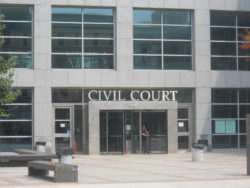
Queens County Civil Court. Image credit: Youngking11.
Owner of a five family house added unit intended for residential use. Nicolae Gogarnow, the owner of a five family house in Queens, lived on the first floor of the house. The house had five residential units, a commercial space that partially occupied the first floor, and an additional unoccupied space on the first floor. Owner Gogarnow filed a petition to evict one of the tenants, Rosalia Silvia. Silvia defended by claiming that she had a right to remain under the rent stabilization law. Owner Gogarnow responded that the building was not covered by rent stabilization because it had only five residential units, one less than the minimum of six residential units needed to trigger application of the rent stabilization law.
Queens County Civil Court Judge John S. Lansden rejected owner Gogarnow’s argument, found that the additional, unoccupied space on the first floor was intended to be a residential unit, and dismissed the petition to evict Silvia.
Judge Lansden ruled that if a unit was intended to be occupied as a residence it would be recognized as a residential unit for purposes of the rent stabilization law. Judge Lansden visited the property and reported that the first floor space, though unoccupied, had a toilet, vanity, shower, AC unit, kitchen cabinets, and a sink, but lacked water or electricity connections. Sheet rock walls had been constructed and rooms made. The Department of Buildings had charged the owner Gogarnow with alterations without a valid certificate of occupancy, and Gogarnow earlier filed plans with Buildings for an additional apartment on the first floor. Based on these facts, Judge Lansden found that the unoccupied space on the first floor was intended to be occupied as a residence, which, as the sixth residential unit, triggered application of the rent stabilization law. Accordingly, Judge Lansden dismissed the petition to evict Silvia.
Nicolae Gogarnow v. Rosalia Silvia, 76 N.Y.S.3d 380 (Civil Ct Queens Cty 2018).
By: Ross Sandler

